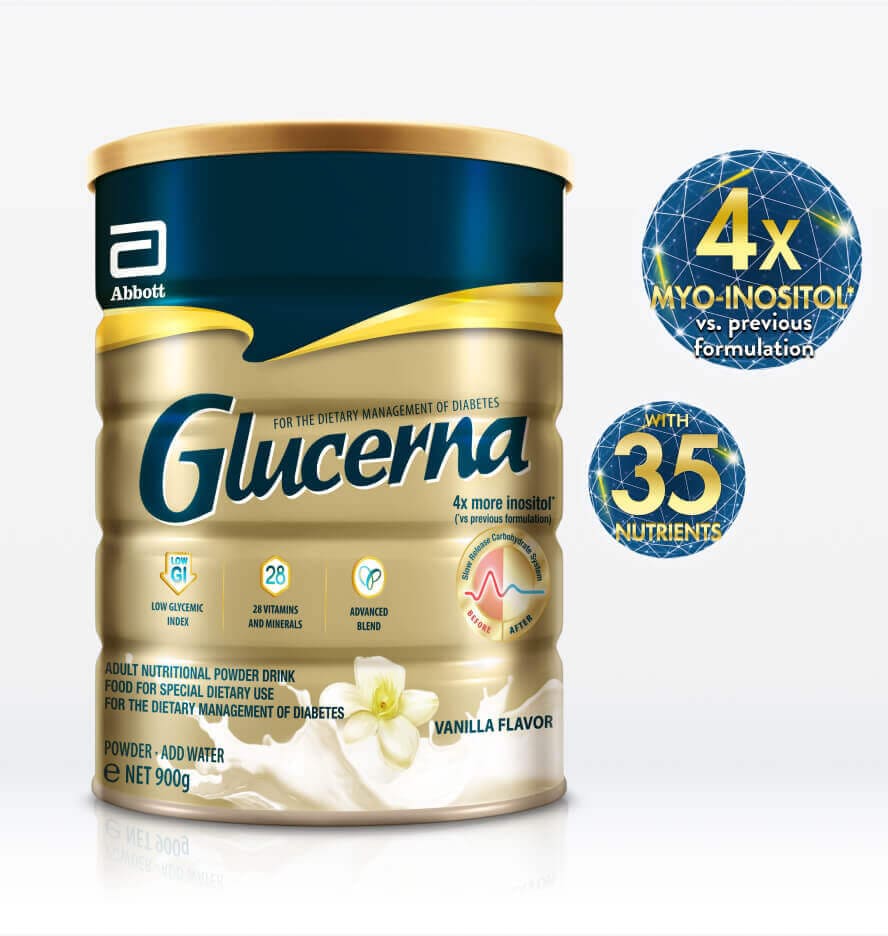Glucerna Vanilla Flavor
- Title
- Glucerna® Vanilla Flavor
- Detail Page Path
Sugars are small and simple carbohydrates. Single sugars, also known as monosaccharides, are single sugar molecules that are small enough to be absorbed directly into the bloodstream. These include fructose, galactose, and glucose. Disaccharides contain two linked sugar molecules that must be broken down into monosaccharides during digestion to be absorbed — these include sucrose (table sugar), lactose (milk sugar), and maltose (malt sugar).
All (including complex) sugar varieties occur naturally in foods like fruit, milk, juice, honey, and, yes, vegetables. The sugars themselves — whether natural or added — are the same molecules. The sucrose in a peach, for example, is the same as the sucrose in a cookie. The difference is that sugars occurring naturally are typically found in more nutrient-dense food. In contrast, added sugars tend to appear in processed food or drinks and increase the calorie count without increasing nutritional value. For a long time, it was difficult to tell whether a food contained added sugars — the nutrition facts label would simply list the total sugar content.
The role of sugar in the diet
Sugars are carbohydrates that serve as the primary energy source in the diet. Regardless of the type of sugar, all sugars are broken down into single sugars (monosaccharides) and travel through the bloodstream to provide energy to cells or are stored for later use. Nutrition guidance typically cautions against including too much (added) sugar in your diet, and for a good reason. Excess sugar intake can be associated with health concerns such as tooth decay, weight gain, and diabetes. But sugar can be a part of a healthy, balanced diet in the proper quantities.
Most healthy adults should aim to get most of their sugar from complex carbohydrates and natural sources like fruit. For picky eaters or people who struggle to get adequate nutrition, sugar can help improve nutrient intake by providing an easily digested source of energy and can enhance the taste of food to make it more palatable. Like those found in some complex carbohydrates and fiber-rich foods, some sugars are slowly absorbed and digested, helping people manage their blood sugar, an important part of diabetes management.
In addition to nutritional value, sugar can also impact our food preferences. Small amounts of sugar can enhance the flavor of food and color and texture, and in some cases, they can also help preserve freshness.
It’s shocking but true: Some foods you love may contain sugar. So keeping an eye on your sugar intake is a vital nutrition best practice. According to the U.S. Department of Agriculture, here’s how much sugar - natural or added - is in 16 food favorites.
Desserts
12 oz can cola = 37 grams ( 9 ¼ teaspoons)
Cookie = 12 grams (3 teaspoons)
Frozen coffee drink 8 oz = 32 grams
1 scoop chocolate ice cream = 21 grams (5 ¼ teaspoons)
Condiments
½ cup Marinara sauce = 6 grams (1 ½ teaspoons)
1 tablespoon coffee creamer = 6 grams (1½ teaspoons)
1 tablespoon balsamic vinaigrette = 4 grams (½ teaspoon)
1 tablespoon ketchup = 4 grams (1 teaspoon)
Fruits and juices
1 cup strawberries = 7 grams (1 ¾ teaspoons)
1 apple = 19 grams (4 ¾ teaspoons)
½ cup applesauce = 21 grams (5 ¼ teaspoons)
1 cup orange juice = 21 grams (5 ¼ teaspoons)
Breakfast
1 cup milk = 13 grams (3 ¼ teaspoons)
6 ounce container Vanilla Greek Yogurt = 16 grams (4 teaspoons)
Oatmeal 1 packet = 13 grams
½ cup Granola = 14 grams (3 ½ teaspoons)
Sugars can turn up in some unexpected places, so it's important to check food labels — even if the foods you're eating don't seem sweet. A nutrition facts label can tell you exactly how many grams of natural and added sugars are in your favorite foods. And the ingredient list will tell you what kind of sugars it contains. Added sugars go by many different names, such as brown sugar, invert sugar, nectar, malt syrup, and high-fructose corn syrup.
Even if you don't have a sweet tooth, keeping an eye on your sugar intake is always good. You may find that weight management becomes more manageable with a little moderation. However, if the science behind sugars remains mystifying, consider sitting down with your doctor or a nutritionist to discuss how you can get just the right amount of natural and added sugars in your diet.
We've all been there, that peckish feeling where you just want to snack on something. For those with diabetes, that almost seems like a sinful act!
Diabetes can affect your appetite, what you eat, and how often you eat. Know which food choice to make to better manage diabetes.
Proper nutrition is the cornerstone of diabetes care. Learn more about eating right for diabetes to help keep your blood sugar in check.
Glucerna® is the number 1 selling diabetes nutritional supplement in the world*. It contains 35 nutrients, slow-release carbohydrates and 4x more inositol vs previous formulation, that delivers a dual action for tight blood sugar control.
* Euromonitor International Limited; total global retail sales in 2023 for diabetic diet enhancer drinks that are not marketed as a meal replacement product. Euromonitor and Abbott calculation based in part on custom research conducted between October and November 2023 and Euromonitor Passport Consumer Health 2023 based on 2022 data.

You are about to exit for another Abbott country or region specific website.
Please be aware that the website you have requested is intended for the residents of a particular country or region, as noted on that site. As a result, the site may contain information on pharmaceuticals, medical devices and other products or uses of those products that are not approved in other countries or regions.
The website you have requested also may not be optimized for your specific screen size.
Do you wish to continue and exit this website?
Stay Connected